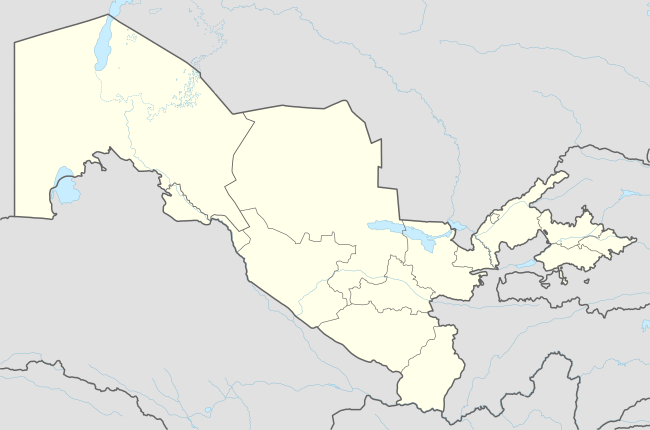Rishton, Uzbekistan
Rishton (Uzbek: Rishton, Tajik: Рештон, Russian: Риштан, alternative spellings Rishtan, Rishdan, Roshidon, previously called also Kyubishev by Russians) is a town (pop est 22,580) in Fergana Region, in Uzbekistan, about halfway between Kokand and Fergana. It is located at latitude 40°21'24N longitude 71°17'5E, and at an elevation of 471 meters.
Rishton Rishton / Риштан | |
|---|---|
 Rishton Location in Uzbekistan | |
| Coordinates: 40°21′24″N 71°17′05″E | |
| Country | |
| Region | Fergana Region |
| Elevation | 471 m (1,545 ft) |
| Population (2019) | |
| • Total | 201,200 [1] |
| Website | www.rishton.uz |
Rishton is one of the most famous and oldest centers of ceramics in Uzbekistan. Legend claims that the art is over 800 years old, passed down from generation to generation. A fine quality reddish-yellow clay deposit 1-1.5 meters deep and 0.5-1.5 meters thick underlies almost the whole Rishton area. The clay can be used without refinement or addition of other types of clay from other regions. Besides clay, the potters of Rishton extracted various dyes, quartz sand, and fire clay from the surrounding the mountains.
One of the most popular Islamic Scholar Burhan al-Din al-Marghinani author of Hidaye was born in this small town and grew up in Margilan, a neighbor city in Fergana.
The history of producing ceramics here goes back to the seventh century. In the late 19th – early 20th centuries, almost all the population of Rishton were potters. Its clay is suitable for making the whole variety of ceramic goods and the repertoire of ornamental patterns in the Rishton ceramics is one of the richest. Today, over 2000 craftsmen use both traditional techniques and modern machinery to produce over 5 million items per year. The traditional design has a blue-green glaze, called “iskor”[2]. In the 1960s, this technique had almost died out, but has now recovered, thanks to the efforts of the artisans themselves.
Main languages spoken in this area are Tajik and Uzbek.
See also
- Burhaniddin Al-Margilani Ar-Rashidani
References
- World Gazetteer.
- "The Rakhimov's Ceramic Studio, Tashkent, Uzbekistan". bizpages.org. Retrieved 2020-02-20.